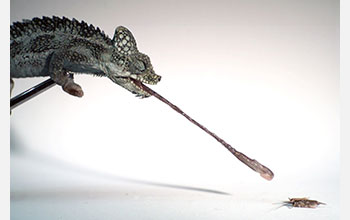Multimedia Gallery
Tiniest chameleons deliver powerful tongue-lashings
Trioceros hoehnelii, one of 20 chameleon species examined in a Brown University study supported by the National Science Foundation.
More about this image
A study by researchers at Brown University found that the ballistic tongue projection in a chameleon so small it can fit on your thumb produced a peak acceleration 264 times greater than the acceleration due to gravity. In other words, the tongue of the chameleon Rhampholeon spinosus can go from 0 to 60 miles per hour in a hundredth of a second, though it only needs about 20 milliseconds to snag a cricket.
"Smaller species have higher performance than larger species," says Christopher Anderson, a postdoctoral research associate in the Department of Ecology and Evolutionary Biology.
Chameleons don’t just use spontaneous muscle power to fling their tongues, rather, they pre-load most of the motion’s total energy into elastic tissues in their tongue. The recoil of those tissues greatly augments what muscle alone can do on the fly--to catch a fly.
To find the upper limit of chameleon tongue performance, Anderson collected 20 species that varied widely in size and perched each one in front of a camera that shoots 3,000 frames a second. Tempting his subjects to eject their tongues by dangling a tasty cricket in front of them, for each "strike," Anderson measured the distance the tongue went, the elapsed time, and the speed and acceleration at any given time. Anderson found that the smaller the chameleon, the higher the peak acceleration, relative power and distance of tongue extension relative to body size. In fact R. spinosus stuck out its tongue a distance of 2.5 times its body length.
Larger chameleons produced impressive motions as well, but not when compared to their smaller cousins. A roughly 2-foot-long species, Furcifer oustaleti, for example, managed a peak acceleration of less than 18 percent that of the tiny champion R. spinosus.
Researchers presume tiny chameleons have evolved to be proportionately better equipped for feeding because like all small animals, they need to consume more energy per body weight to survive. They must be especially good at catching their insect meals to compete for their required nutrition.
Anderson says when studying physical performance, it will benefit researchers to pay attention to the smaller species. "What this study shows is that by using smaller species, we may be able to elucidate these higher performance values," he says.
This research was supported in part by a grant from the National Science Foundation (grant IOS 08-42626).
To learn more about this research, see the Brown University news story Tiniest chameleons deliver most powerful tongue-lashings. (Date image taken: July 2010; date originally posted to NSF Multimedia Gallery: Nov. 14, 2016)
Credit: Christopher V. Anderson, Department of Ecology and Evolutionary Biology, Brown University
Images and other media in the National Science Foundation Multimedia Gallery are available for use in print and electronic material by NSF employees, members of the media, university staff, teachers and the general public. All media in the gallery are intended for personal, educational and nonprofit/non-commercial use only.
Images credited to the National Science Foundation, a federal agency, are in the public domain. The images were created by employees of the United States Government as part of their official duties or prepared by contractors as "works for hire" for NSF. You may freely use NSF-credited images and, at your discretion, credit NSF with a "Courtesy: National Science Foundation" notation.
Additional information about general usage can be found in Conditions.
Also Available:
Download the high-resolution JPG version of the image. (259.4 KB)
Use your mouse to right-click (Mac users may need to Ctrl-click) the link above and choose the option that will save the file or target to your computer.

